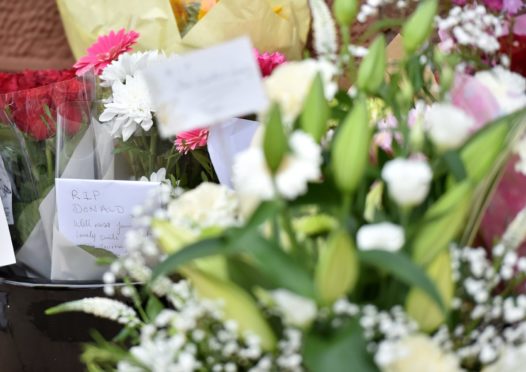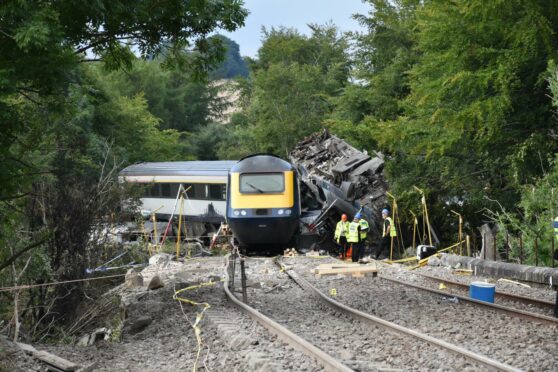Network Rail facing criminal charges over Stonehaven rail tragedy
A rail body is facing criminal charges related to the Stonehaven rail crash in which three people died.
Network Rail has been charged in connection with the tragedy on August 12 2020,[1] with more details due next month.
According to a new court rolls document, the Crown Office will prosecute Network Rail and a hearing is due to take place at the High Court in Aberdeen on September 7.
Network Rail has chosen not to say what the charges are in case the situation changes before the hearing.
Train driver Brett McCullough, passenger Christopher Stuchbury and conductor Donald Dinnie died in the tragedy. Six others were injured.
The 6.38am Aberdeen to Glasgow train left the tracks at Carmont, near Stonehaven, after hitting a landslip caused by a night of extreme rainfall.
 Neil Davidson, partner at Digby Brown, which is representing some of the Stonehaven rail crash victims and their families.
Neil Davidson, partner at Digby Brown, which is representing some of the Stonehaven rail crash victims and their families.
Neil Davidson, Partner at Digby Brown Solicitors in Aberdeen, which is representing some of the victims, said: “For nearly three years bereaved families and injured survivors have waited patiently for answers so the update of these criminal proceedings is generally positive.
“However, it is what actually transpires from the hearings that is important such as the nature of the charge, the outcome of the prosecution and any other information that sheds light on the mindsight of those in charge at Network Rail.
“It is fair to say that each person and family affected by this tragedy will be looking for different things from this hearing and we will continue to support our clients in their pursuit for justice and recognition.”
Safety recommendations still not in place
In the aftermath of the collision, the UK Government ordered two investigations.
One was led by Police Scotland, British Transport Police and the Office of Rail and Road, which reported its findings to the Crown Office.
The other was carried out by the Rail Accident Investigation Branch[2], which reported its findings in March 2022.
 Flowers left in tribute to the victims at Stonehaven Rail Station.
Flowers left in tribute to the victims at Stonehaven Rail Station.
We reported in May how Network Rail was still to implement 18 of the Rail Accident Investigation Branch’s 20 recommendations[3] 14 months after they were made.
‘A terrible day for our railway’
RAIB’s recommendations are aimed at improving Network Rail’s response to bad weather, flooding and lineside drainage to minimise the chances of a repeat of the crash.
Last year, the Office of Rail and Road (ORR) raised concerns about how Network Rail was addressing the recommendations made after the disaster[4], although some progress has since been made and their assessment updated.
 The Stonehaven rail crash accident site at Carmont. Image: Rail Accident Investigation Branch.
The Stonehaven rail crash accident site at Carmont. Image: Rail Accident Investigation Branch.
A Network Rail spokesperson said: “The Carmont derailment and the tragic loss of Christopher Stuchbury, Donald Dinnie and Brett McCullough was a terrible day for our railway and our thoughts remain with their families and all those affected by the accident.
“While we cannot comment on the ongoing legal process, the RAIB report into Carmont made clear that there were fundamental lessons to be learnt by Network Rail and we have supported the investigation process.
‘We’ve made significant changes’
“Since August 2020, we have been working hard to make our railway safer for our passengers and colleagues.
“We are committed to delivering on the recommendations made by RAIB and have also made other significant changes to how we manage the risk of severe weather to our network.
“Immediately after the accident, we inspected all similar locations across Britain and we also conducted a full survey of all types of trackside drainage on Scotland’s Railway.
 Rail staff at Dundee observe a minute’s silence in memory of the crash victims at a ceremony in 2021. Image: Steve Brown
Rail staff at Dundee observe a minute’s silence in memory of the crash victims at a ceremony in 2021. Image: Steve Brown
“We have invested millions towards improving the resilience of our railway and are rolling out new technology to help us better respond to extreme weather events.
“We have also changed how we manage the running of train services during periods when severe weather warnings are in place and have introduced a new team of weather experts to our control room to provide around-the-clock, real-time analysis on how the weather may affect Scotland’s Railway.
“From our day-to-day operations to our future planning, we are working hard to make our railway as safe and reliable as possible.”
The 06:54 from Stonehaven: Analysis, investigation and how a community pulled together in the face of tragedy[5]
References
- ^ tragedy on August 12 2020, (www.pressandjournal.co.uk)
- ^ Rail Accident Investigation Branch (www.gov.uk)
- ^ still to implement 18 of the Rail Accident Investigation Branch’s 20 recommendations (www.pressandjournal.co.uk)
- ^ raised concerns about how Network Rail was addressing the recommendations made after the disaster (www.pressandjournal.co.uk)
- ^ The 06:54 from Stonehaven: Analysis, investigation and how a community pulled together in the face of tragedy (www.pressandjournal.co.uk)